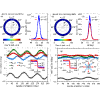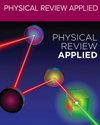有孪晶和无孪晶 Ni(111) 薄膜中的立方磁光克尔效应
IF 4.4
2区 物理与天体物理
Q2 PHYSICS, APPLIED
引用次数: 0
摘要
在大多数利用磁光克尔效应(MOKE)的研究中,从磁化样品反射时检测到的偏振光变化应该与磁化率 M 成正比。然而,与 M 成二次方的 MOKE 信号也已被识别和利用,例如,用于感知 Heusler 化合物中的结构秩序、检测自旋轨道力矩或成像反铁磁域。在我们的研究中,我们观察到镍(111)薄膜中 M 的三阶强各向异性 MOKE 贡献,归因于立方磁光张量∝M3。我们还进一步证明,立方磁致光学(CMOKE)的角度依赖性受到样品中结构域孪晶数量的影响。我们对 CMOKE 的详细研究将为对薄膜孪晶特性敏感的 CMOKE 应用提供机会,例如 CMOKE 光谱和显微镜或时间分辨 CMOKE。此外,当使用垂直入射光时,CMOKE 可检测面内磁化取向,这适用于不提供斜入射光的 MOKE 设置。本文章由计算机程序翻译,如有差异,请以英文原文为准。

Cubic magneto-optic Kerr effect in Ni(111) thin films with and without twinning
In most studies utilizing the magneto-optic Kerr effect (MOKE), the detected change of polarized light upon reflection from a magnetized sample is supposed to be proportional to the magnetization . However, MOKE signatures quadratic in have also been identified and utilized, e.g., to sense the structural order in Heusler compounds, to detect spin-orbit torque or to image antiferromagnetic domains. In our study, we observe a strong anisotropic MOKE contribution of third order in in (111) thin films, attributed to a cubic magneto-optic tensor . We further show that the angular dependence of cubic MOKE (CMOKE) is affected by the amount of structural domain twinning in the sample. Our detailed study on CMOKE will open up opportunities for CMOKE applications with sensitivity to twinning properties of thin films, e.g., CMOKE spectroscopy and microscopy or time-resolved CMOKE. Furthermore, the in-plane magnetization orientation can be detected with CMOKE when perpendicular incidence light is used, which is suitable for MOKE setups that do not provide oblique incidence.
求助全文
通过发布文献求助,成功后即可免费获取论文全文。
去求助
来源期刊

Physical Review Applied
PHYSICS, APPLIED-
CiteScore
7.80
自引率
8.70%
发文量
760
审稿时长
2.5 months
期刊介绍:
Physical Review Applied (PRApplied) publishes high-quality papers that bridge the gap between engineering and physics, and between current and future technologies. PRApplied welcomes papers from both the engineering and physics communities, in academia and industry.
PRApplied focuses on topics including:
Biophysics, bioelectronics, and biomedical engineering,
Device physics,
Electronics,
Technology to harvest, store, and transmit energy, focusing on renewable energy technologies,
Geophysics and space science,
Industrial physics,
Magnetism and spintronics,
Metamaterials,
Microfluidics,
Nonlinear dynamics and pattern formation in natural or manufactured systems,
Nanoscience and nanotechnology,
Optics, optoelectronics, photonics, and photonic devices,
Quantum information processing, both algorithms and hardware,
Soft matter physics, including granular and complex fluids and active matter.
 求助内容:
求助内容: 应助结果提醒方式:
应助结果提醒方式:


